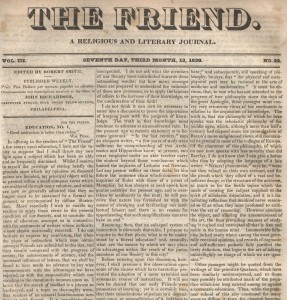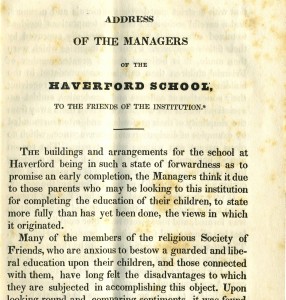“In laying the foundation of a good education, those parts of the multifarious mass of human knowledge must be selected, the study of which is most strengthening to the faculties, and the application most useful in the affairs of life.”— Board of Managers Address, 1833
Born out the desire for Quaker sons to become scholars of Classical men, Haverford came to fruition as both bold in its ambitions and careful in its curriculum. Haverford aimed to create a space where Orthodox Quaker men could strengthen their convictions and pursue scholarship, including a curriculum focused on mathematics, the Classics, and religious training. In addition, the Quaker community saw books, especially those in schools, as a way to engage the broader community.
In 1837, The Friend; a Religious and Literary Journal reports on a book committee formed by the Philadelphia Yearly Meeting to create collections of “suitable reading” for Haverford and Westtown schools. “The books have been interesting to, and much read by pupils, and of course would divert their attention from less valuable reading; they would also more or less influence the course of reading in families; a circumstance worthy of notice.” Indeed, The Friend as well as the Haverford student publication warned its readership against the dangers of “trashy novels” (as all novels were).
Reading was not only a practice of scholarship, it was also one of faith. Caution about certain kinds of reading was common beyond the Orthodox Quaker community during the19th century. Many felt that women and youth were particularly susceptible to passions and temptations of the novel in its content and imaginative genre.
The Friend concluded to its readership that “In a moral and religious view the practice of novel reading is highly pernicious.” But of particular note in this reporting back is that the The Friend positions the practice of reading as deeply tied to its community. The students of these Quaker schools were already becoming community exemplars of scholarship and inquiry. Students in these schools, were poised to lead the community through their scholarly influence.
- The Friend
- Address of the Managers




